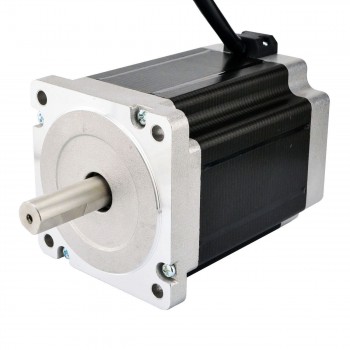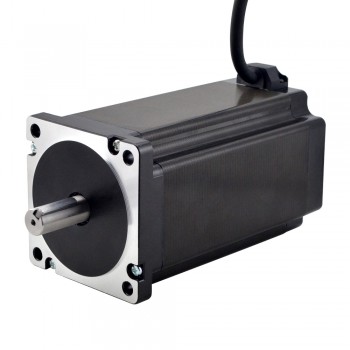1. A brief introduction to hybrid stepper motors
Hybrid stepper motors are a type of motor that combines the advantages of permanent magnet stepper motors and reactive stepper motors. It has high output torque and high step accuracy, and is widely used in industrial automation and precision control, especially as a drive device in economical CNC machine tools. Its high precision, high reliability and good speed regulation performance make it perform well in these fields.
2. The main structure of hybrid stepper motors
The main structure of hybrid stepper motors includes three parts: stator, rotor and armature. The stator is usually composed of a combination of a reluctance winding and a wound winding of a traditional stepper motor. The stator is equipped with a multi-way winding structure and a permanent magnet on the periphery; the rotor is composed of a magnet and a small reluctance magnetic needle of a traditional stepper motor; the armature is composed of a regulating reluctance and a power supply, which is used to control the rotation direction and step of the motor.
3. Design requirements for hybrid stepper motors
1. Performance requirements: Hybrid stepper motors need to meet specific performance indicators, including step angle accuracy, torque fluctuation, etc. The motor should work normally under the specified power supply and load conditions to ensure reliability and stability in practical applications.
2. Structural requirements: The rotor of the hybrid stepper motor itself is magnetic, which makes the torque generated under the same stator current greater than that of the reactive stepper motor. However, its structure is relatively complex, the rotor inertia is large, and the rapidity is low.
3. Material selection: Hybrid stepper motors are usually made of high-temperature resistant permanent magnets and high-quality cold-rolled steel sheets to ensure the reliability and stability of the motor. In addition, the selection of high-quality bearings and appropriate surface treatment can also improve the performance of the motor.
4. Environmental adaptability: Hybrid stepper motors should have good environmental adaptability and be able to operate stably in different working environments. This includes characteristics such as high temperature resistance and moisture resistance.
5. Test methods: The national standard specifies the test methods for hybrid stepper motors, including performance tests, environmental adaptability tests, and durability tests. These test methods ensure that the motor meets national standards and provide a basis for quality control and selection.

4. Quality judgment method of hybrid stepper motor
1. Appearance inspection: First observe whether the overall structure of the motor is complete, whether the cable connection is normal, and whether there is no damage or breakage. At the same time, check the nameplate or label on the motor to understand its model, voltage and other information to ensure that it meets the equipment requirements.
2. Resistance measurement: Use a multimeter to adjust the motor to the resistance range (such as 10K ohms), disconnect the power connection and signal line connection, and measure the resistance value of the motor coil. If the displayed resistance value is close to infinity, it means that the motor coil is basically normal; if the displayed value is very small, the motor may be short-circuited or open-circuited. In addition, the resistance values measured at both ends of the motor should be almost equal, otherwise it may be caused by motor bearing wear, stator and rotor misalignment, etc.
3. Power-on test: Connect the motor to the power supply and observe its working status. Under normal circumstances, the motor should be able to work normally, rotate flexibly and without abnormal sounds. If the motor does not turn or turns with difficulty, it may be a motor failure.
4. Speed and torque detection: Use a tachometer or other measuring tools to measure whether the speed and torque of the motor meet the requirements of the specification. If the speed or torque is significantly lower than the nominal value, it means that the motor performance is poor.
5. Noise detection: During the operation of the motor, use a noise meter or other measuring tools to record its noise level. If the noise is significantly greater than the nominal value, it means that the motor performance is poor.
6. Life test: In actual applications, the motor is tested for a long time to observe its service life. If the motor fails or its performance deteriorates in a short time, it means that its quality is poor.
7. Professional equipment detection: For some complex parameters, such as phase, phase angle, etc., professional motor testing equipment can be used for detection. These devices have high precision and can more accurately judge the quality of the motor.

